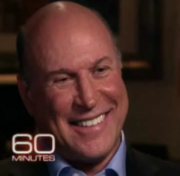Excerpt:
Rick Berman
From SourceWatch
 | This article is part of the Tobacco portal on Sourcewatch funded from 2006 - 2009 by the American Legacy Foundation. Help expose the truth about the tobacco industry. |
 | This article is part of the Center for Media & Democracy's spotlight on front groups and corporate spin. |
He is the President, Executive Director and Director of the Center for Consumer Freedom (CCF). CCF's 2005 IRS return states that Berman works 23 hours a week for the group for which he is paid $18,000. [1] In spite of its name, CCF is more concerned about industry than the consumer. He is also the Executive Director and President of the Employment Policies Institute Foundation the American Beverage Institute and the Center for Union Facts. [2]
According to a July 31, 2006, profile of Berman in USA Today, his company has 28 employees and takes in $10 million dollars a year, but "only Berman and his bookkeeper wife" know how much of the $10 million ends up in their own pockets. [2]
Rick Berman has earned the nicknames "Dr. Evil," the "Conservatives' Weapon of Mass Destruction" and the "Astroturf Kingpin" for his repeated use of the strategy of forming non-profit front groups that advocate for the interests big business while shielding those same businesses from disclosing financial support for these efforts.[3][4]
Center for Consumer Freedom
Excerpt:
The Center for Consumer Freedom (CCF) (formerly called the "Guest Choice Network (GCN)") is a front group for the restaurant, alcohol, tobacco and other industries. It runs media campaigns which oppose the efforts of scientists, doctors, health advocates, animal advocates, environmentalists and groups like Mothers Against Drunk Driving, calling them "the Nanny Culture -- the growing fraternity of food cops, health care enforcers, anti-meat activists, and meddling bureaucrats who 'know what's best for you.'"
CCF is registered as a tax-exempt, non-profit organization under the IRS code 501(c)(3). Its advisory board is comprised mainly of representatives from the restaurant, meat and alcoholic beverage industries.
http://www.sourcewatch.org/index.php?title=Middle_East_Free_Trade_Area
Excerpt:
Existing Free Trade Agreements
According to the Office of the U.S. Trade Representative, the following is the status of Middle East trade agreements as of March 2, 2006:- U.S.-Israel Free Trade Agreement (in force since 1985)
- U.S.-Jordan Free Trade Agreement (in force since 1990)
- U.S.-Morocco Free Trade Agreement (in force since 2005) [2]
- U.S.-Bahrain Free Trade Agreement (signed September 2004, entry into force in 2006) [3]
- U.S.-Oman Free Trade Agreement (negotiations concluded September 2005)
- U.S.-United Arab Emeriates (UAE) Free Trade Agreement (launched negotiations March 2005)
Overview
On May 9, 2003, President George W. Bush "proposed a plan of graduated steps for Middle Eastern nations to increase trade and investment with the United States and others in the world economy. The first step is to work closely with peaceful nations that want to become members of the World Trade Organization (WTO) in order to expedite their accession. As these countries implement domestic reform agendas, institute the rule of law, protect property rights (including intellectual property), and create a foundation for openness and economic growth, the United States will take a series of graduated steps with countries in the region tailored to their level of development. The U.S. will expand and deepen economic ties through Trade and Investment Framework Agreements (TIFAs), Bilateral Investment Treaties (BITs), and comprehensive Free Trade Agreements (FTAs), and will enhance the Generalized System of Preferences (GSP) program for eligible countries." --Office of the U.S. Trade Representative.http://www.skeptically.org/wto/id8.html
Excerpt:
Free Trade Area of the Americas
The Free Trade Area of the Americas (FTAA), currently being negotiated by 34 countries of the Americas


No comments:
Post a Comment